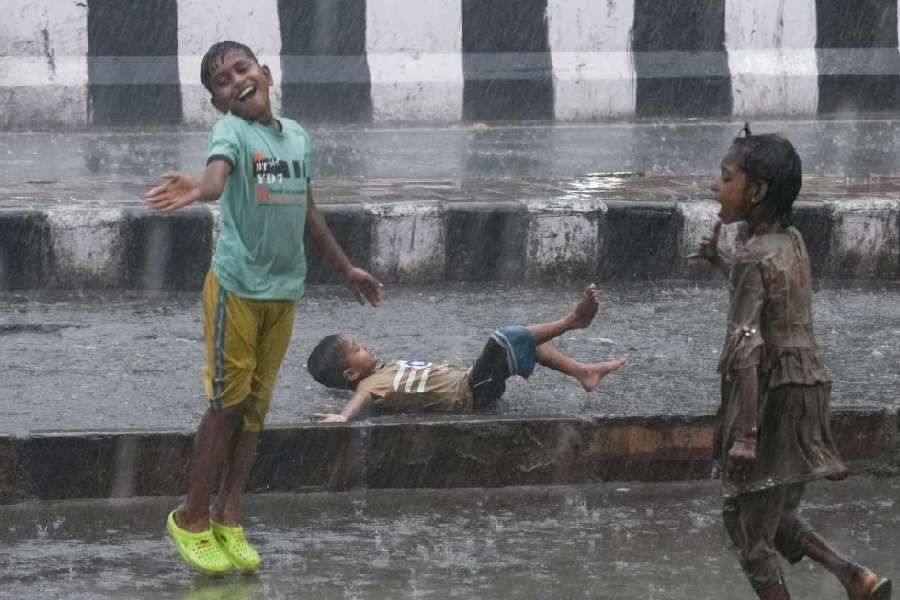 |
For seven-year-old Agnish Ray, a resident of Ekdalia Road, his home is his playground. He lounges in his room, or in the drawing room sofa.
“I love to shop for toys and mom and I have fun playing with them,” he chirps. When he gets bored with toys, he would rather chat with his mother’s friends, sketch in a quiet corner or turn to the good old TV. If he feels like going out to play, he chooses the play area of a mall. “You have everything there — cars, bikes, trains. I like all the rides,” he says.
It’s not Agnish’s fault. Parks and playgrounds in several areas of the city are off limits for children. Ekdalia Park just outside Agnish’s house is in a shambles with its swings broken and the benches covering a patch of greyness. During Durga Puja, the fences and swings were given a fresh coat of paint. But they still remain grey and unsuitable for play.
The mall is the answer for five-year-old Suva, a resident of Hindustan Road, who is often irritable at the prospect of cycling alone on the sidewalk in front of his house. “As compensation we have to allow him extra time in front of the telly. During weekends he has to be taken to the playzone in a mall,” says his mother Priyabrota Ghosh. For Suva the mall play-areas are his socialising zones where he gets to meet his school friends and other children. “It is difficult to drag him away from that area on a Sunday,” adds his mother.
Several upmarket areas of the city, such as New Alipore, Hindustan Road, Ekdalia Road, Fern Road and Ballygunge Place, where residents sometimes have to shell out more than Rs 5,000 per square feet to buy a home, have no parks for their children.
“It’s sad that most kids don’t even know that they should be out playing in the evenings,” says Tandrima Adhikary, a mother of a three-year-old. To compensate, parents enrol their kids in activity classes, ranging from singing, dancing and drawing to martial arts, etiquette and horse riding from as young as three years. Or take them to the mall.
Child psychiatrists are disapproving.
“Children model their surroundings as part of their learning process and video games tend to stimulate disruptive, hyperactive or violent behaviour in children, as well as compromise their social skills,” says clinical psychologist Shatabhisha Chatterjee. Child counsellor Fuljhuri Basu says a child who does not play in the evenings often suffers from attention deficit disorder and boredom forces him to skip from one activity to another.
But all roads lead to the malls on a holiday. According to Sourav Bose of Timezone, the play area in South City, the footfall often crosses 3,000 on weekends.
In contrast, entertainment parks seem to draw less of children and more of lovebirds. Of the 16 million visiting Nicco Park in a year, only 25 per cent are children and the rest are adults and teenagers, says the MD and CEO of Nicco Park, Arijit Sengupta.
In the absence of playgrounds, clubs are also an attractive destination for children.
The children’s park at Tolly presents an idyllic scene on a weekday evening. Sounds of laughter and shrieks of delight float out from the children’s park, as a group of children, between two and five years, play there, making good use of the swing and other rides. Their mothers sit chatting a little distance away.
Deepti Mohinder, a resident of New Alipore, gets her children, five-year-old Sarah and two-and-a-half-year-old Shireen, to the club twice a week. “Otherwise they just sit at home and watch TV,” she says.
Club authorities realise the importance of having a children’s park on the premises. “The children’s park is extremely popular. It is close to the pool, so they can play and then take a swim. We hold summer camps and nature walks,” says Tolly managing member Anil Mukerji. The Saturday Club and Dalhousie Institute have play-areas for the tots.
“The children’s play area is very popular, especially on weekends,” says Denise O’Brien of DI.
Even when renovated, as Harish Mukherjee Park was, a park may not attract many children.
Bonani Kakkar of the environment NGO PUBLIC (People United for Better Living in Calcutta), who points out that several schoolchildren tend to be obese these days, stresses that the problem is more the inaccessibility of parks.
“It’s fashionable these days to enrol children in various creative activities. The reason is not always the scarcity of parks but their inaccessibility. A large area of many parks are cordoned off and used as coaching camps and for various social and political activities,” she says.
“On top of it, beautification and erection of statues and memorials eat into the children’s play area. Many parks like Deshapriya Park and Loudon Park remain locked for several hours,” adds Kakkar.
Vivekananda Park off Southern Avenue has been partially taken over by a cricket coaching academy.
The civic records show 650 parks in the city. Many of them are badly maintained.
Many parents do not want to send their children to parks because of the presence of anti-social elements. In a growing trend that is possibly an indication of the hardening of the lines of class division in the city, upper- and middle-class parents also do not send their children to play in many parks because “children from adjoining slums” play there.
Eight-year-old Aarohini Ghosh of Jodhpur Park shuttles between swimming and other activity classes. “I want to play in a park,” she says, but her mother does not approve of the crowd in the one near home. So “playtime” means a once-a-week trip to a nearby Safari Park, a children’s park near the lake.
No wonder many working couples are opting for smaller flats in residential complexes only to give their children a healthy outdoor life.
Indira Sengupta moved from a spacious three-storey house in Deodar Street in south Calcutta to a smaller flat in the South City complex. Her two sons, five- and three-year olds, had no place to play in their locality.
“The play area in our complex is huge. It has many swings, slides, a jungle gym and even a sand-pit. My sons can now play as long as they want to, even after sundown, without me worrying about their safety,” she says.
The plusher the complex, the more extravagant their play areas. Shukla Malhotra’s seven-year-old daughter was in for a treat when her new home in a residential complex in Northern Avenue had slides like the ones in Nicco Park. “Now my daughter will not miss out on going to entertainment parks,” says the happy mother.
Kakkar stresses the need to go back to open space. “Not just children, given the high pollution level in the city, every citizen needs to go back to parks and start the day amidst some greenery. We need to organise more events in parks and upgrade them, to help people get into the habit of visiting them again,” she says.
Green space vs concrete jungle
In 2000, Calcutta had 0.95 per cent of its area as organised green areas (the international standard is 15 per cent)
Calcutta’s green cover steadily depleted from 1.3 per cent in 1997-98 to 0.95 per cent in 1999-2000
A 1996 report found that 23 of Calcutta's 100 wards had no organised open space
Calcutta Municipal Corporation claims there has been marginal improvement of late
CMC records show that the core city has about 200 parks, many of which are heavily encroached
There are about five wards in north and central Calcutta that do not have a park
The situation is marginally better in the added areas, with about 450 parks, but many of these aren’t maintained properly and can hardly be called “green” spaces
(According to studies conducted by Delhi-based National Institute of Environment Studies; Sustaining Calcutta, a CMDA report; and CMC sources)
Jayanta Basu











